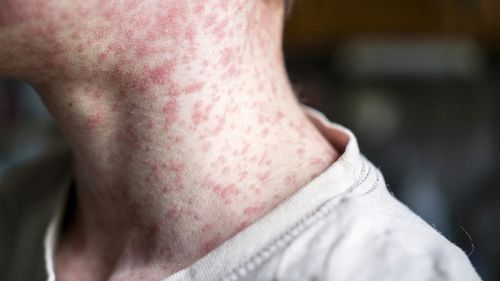Measles case numbers reached record lows in Australia during the COVID-19 pandemic, but are on the rise again as the highly contagious infection makes a resurgence around the world.
Endemic measles were eliminated in Australia in 2014 and though outbreaks still occur around the country, most cases can be traced back to overseas infections.
These outbreaks are also quickly contained to prevent the infection from spreading and the last time Australia recorded more than 60 cases in a single year was in 2019.

But measles are experiencing a resurgence around the world, with outbreaks recorded in several countries frequented by Australian travellers, including the US, Thailand, Indonesia, and Vietnam.
Other countries currently experiencing outbreaks include Yemen, Pakistan, India, Ethiopia, Romania, and Afghanistan.
Here’s everything you need to know about measles in Australia , including current outbreaks and vaccination information.
Is there a measles outbreak in Australia now?
There have been a number of measles cases reported in Australia in 2025, however the Australian Department of Health has indicated that current case numbers are on par with previous year-to-date figures.
In the first three months of 2025, New South Wales and Victoria have both recorded 13 cases each.
At least two cases have also been reported in Western Australia, including one in February in which the infected individual attended a Drake concert at Perth’s RAC Arena.
Can you get measles if you’ve been vaccinated?
Studies estimate that one in 100 people who have received two doses of measles vaccine will develop measles if exposed to the infection. It is unclear why.
Vaccinated people tend to develop milder symptoms.

Is the measles vaccine safe?
Measles vaccines are a proven safe and effective way to protect from infection and are available to most Australians.
In Australia, measles combination vaccine is recommended for children at 12 and 18 months and is free under the National Immunisation Program.
Infants can be vaccinated as young a six months in some circumstances, such as if they are travelling overseas.
Vaccination is delivered in the form of the MMR (measles, mumps, rubella) vaccine at 12 months and the MMRV (measles, mumps, rubella, varicella) vaccine at 18 months.
Some people are also eligible for a free catch-up vaccination if it is recommended and they were not vaccinated as children.
According to the Australian Government Department of Health and Aged Care, all people born during or since 1966 should have either received two doses of measles-containing vaccine or medical proof of immunity to measles, mumps and rubella.
What are the symptoms of measles?
Measles symptoms usually appear seven to 18 days after infection.
The most well-known symptoms of measles are a flu-like illness, which typically lasts two to four days, and a blotchy red rash.
The rash typically appears on the neck or face two to seven days after the symptoms start, then spreads to the body. It does not itch but can last four to seven days.
Other common measles symptoms include:
- fever
- cough
- runny nose
- tiredness
- conjunctivitis
- white spots in the mouth called Koplik’s spots
In severe cases, which are not uncommon, other complications can arise including lung infection (pneumonia), ear infection, and brain inflammation (encephalitis).

Where Australia ranks in countries with the greatest health freedoms
When was the last major measles outbreak in Australia?
Though the World Health Organization (WHO) declared Australia had eliminated endemic measles in 2014, there have been several contained outbreaks in the years since.
These outbreaks typically begin when an Australian resident travels abroad, becomes infected, then returns to Australia, where the infection then spreads.
The most significant spike in measles case numbers in recent years was in 2019, when more than 280 cases of measles were recorded (almost three times the number that had been recorded the year prior) across more than 30 outbreaks.
Most of the outbreaks were traced back to Australian residents returning from overseas.
Lockdowns and social distancing regulations during the COVID-19 pandemic saw case numbers plummet to just 25 in 2020 and zero in 2021.
Only seven cases were recorded in 2022, followed by 26 in 2023 and 57 in 2024.
How can I track measles outbreaks and health alerts?
Stay across current measles outbreaks and health alerts by monitoring your state government’s Department of Health websites:





